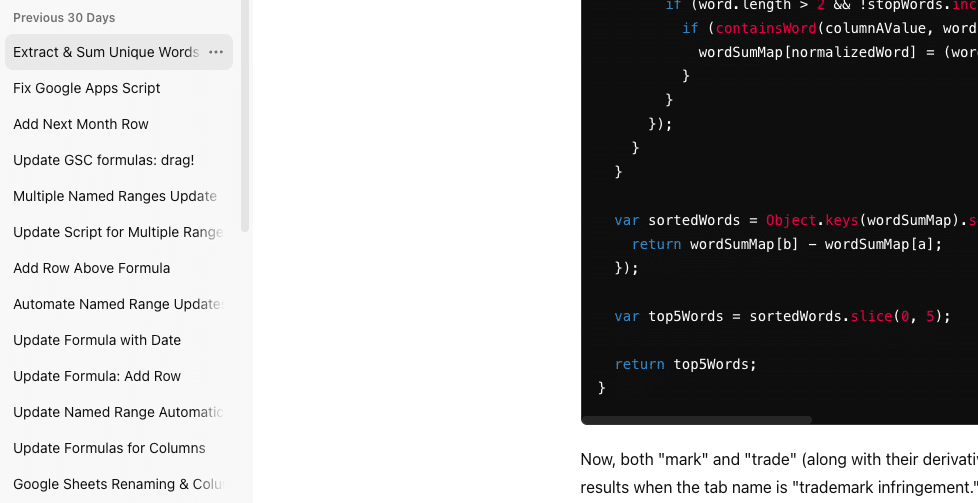AI-generated content: The dangers of overreliance

If you’re chasing trends right now to try and spike your traffic – and by that, I mean choosing the tactic of the week, like using generative AI or large language models (LLMs) without investigating their viability or whether they match your strategy and business – it will probably come back to bite you.
The pitfalls of trend-chasing: Staying true to your brandIn business, there’s a long-standing concept brought back into the conversation by folks like Simon Sinek. When you pit yourselves against someone else in your industry and want to “win” against them, you’re bound to lose.
Business isn’t a finite battle, but often, we act like it is. The goal of a business is to keep operating, not necessarily to “win” against our competitors.
Apple never blinked an eye at Microsoft’s Zune, which might be a better product than theirs. Apple was simply trying to do its best to help its customers live their best lives. A few months after the Zune’s release, Apple released the iPhone, which made that whole product vertical nearly obsolete. Yet, that was seemingly not Apple’s primary goal in creating the iPhone.
In the best world as a business, you’re playing an infinite game, only looking to get better against your old “self” – constantly iterating on your product or service to be incrementally better than you were before.
Many businesses or individuals feel like they need to chase trends because “everyone is doing it,” which is intrinsically comparative: you want, if not to be better than everyone else, at least be the same.
Following trends this way often leads to action without planning, neglecting how it fits into your marketing mix, whether your ideal clients spend time there and other important considerations for business strategy and tactics.
All this hasty decision-making to “join the bandwagon” can lead to a sunk cost fallacy for the business later down the line.
And jumping on the bandwagon for something like using AI or LLM bots to fully write your content for you – that’s going down a path that could actively harm your business, not just in the long term but also in the short term, because of the effort Google is putting into detecting content that is search-engine first rather than people first.
Dig deeper: How to survive and thrive in a Google helpful content world
Considerations when using ChatGPTAs a business owner myself, I can tell you I only use ChatGPT one way: to create Excel, Colab and Google Sheets formulas.
I don’t touch content in any way, shape or form with an AI or LLM model. And I’ll tell you why.
 A screenshot of the author’s queries to ChatGPT in the last 30 days
Tone of voice and brand consistency
A screenshot of the author’s queries to ChatGPT in the last 30 days
Tone of voice and brand consistency
Consumers absolutely buy the “why.” We care about things like supply chain transparency, carbon footprint offset and more. We care about “thinking differently.”
That “why”, when you get it right, is the foundation of your brand. And that is a gold standard you always want to refer back to.
If you’re taking content spun up straight from a prompt into your preferred AI platform, you probably will not be getting something back that sounds like your brand and editing it to sound like your brand could very easily take more time than it would take to write that article yourself in the first place.
While I’ve not worked with a brand-grounded AI or LLM model myself, I would even be skeptical of that grounded content actually sounding like your brand. Nuances in brand tone are sometimes difficult to codify into a formula, a yes/no or if/else statement.
The consistency of the content can be spotty from one topic to another with ChatGPT and LLMs as well because it depends on the level of quality of the information already published on the web and whether or not that model has actually seen that content.
If you’re working with a particularly niche or specialized topic – or even something subjective, like how the specs on a camera affect the artistry of the photograph, you may end up with a drastically inconsistent spun-up article because there is no consensus on the Internet about it.
Get the daily newsletter search marketers rely on.
Business email address Subscribe Processing... Repetition and information gainIntrinsically, AI and LLMs cannot create new information unless you’ve written your own, and you can add new content into the corpus, like, say, your sales or support transcripts.
Most folks using tools like this probably aren’t paying that money and going to that depth when using AI; it’s being used as a timesaving tool, so why would that much upfront time go into it?
If you’re using an open-source web model, you’re using the same information already on the web (or whatever percentage of it the tool scraped), repurposed, copied and pasted in a slightly different way with a few hallucinations thrown in for some spice.
In many ways, this entirely defeats the general purpose of content on your website: to provide information relevant to your specific users or customers, potential or current.
With the algorithm updates in the last 18 months, we have a sense of how actively Google is trying to weed out unhelpful, duplicate or near-duplicate content.
That’s been reinforced with the babyPanda function in the recently leaked documentation, which, while seeming separate from the HCU algo changes, indicates the focus on unique content has been there as an explicit factor for a while and a continued factor even after Panda was fully integrated into the main algorithm.
When creating content for your website and playing the infinite game, you want to create something that’s uniquely beneficial to your customers.
If they’ve told you themselves they’re looking for an answer to x or y, all the better. However, the likelihood that a tool like ChatGPT would be able to generate something that actually directly answers that question with 100% accurate information is slim to none.
E-E-A-TWhen you use a tool to create content, for example, using it to ghostwrite for a busy subject matter expert and requesting the SME to review, you’ve already created a bias in the content itself.
It’s possible that if you gave the same brief to the SME to write when they had the time, they would take an entirely different approach to the topic. However, because either you input the headings or the model creates them for you, the benefit of that other direction may be entirely lost.
Additionally, an AI or LLM-generated article is unlikely to prompt original thought in the SME when they’re reviewing – so how, then, can this article be considered authoritative?
It’s simply a regurgitation of known facts and standard recommendations, likely with no perspective or angle. That angle often helps cement authority in a space and by using an AI or LLM-generated content base, you may be removing that unique perspective entirely.
Dig deeper: How relying on LLMs can lead to SEO disaster
Really think about why you want to use an AI or LLMMany businesses feel pressure to write all the content or publish a blog article a week, a day, or an hour, or to feel like they need to have content for every variation of best/cheapest/newest/most features.
Instead of focusing on volume and feeling the pressure to use AI to publish X number of articles a week, focus on what is actually valuable for your customers and your business.
